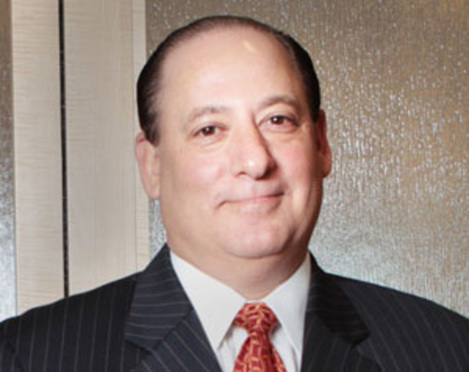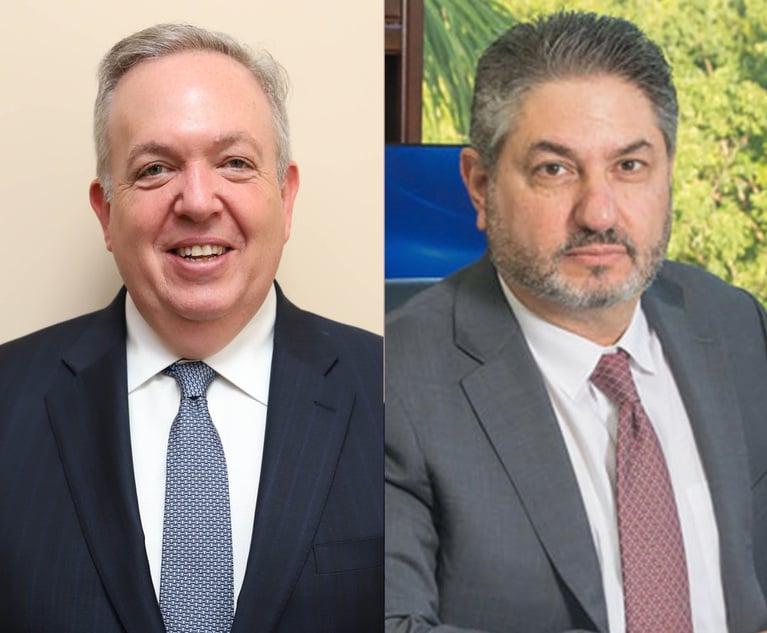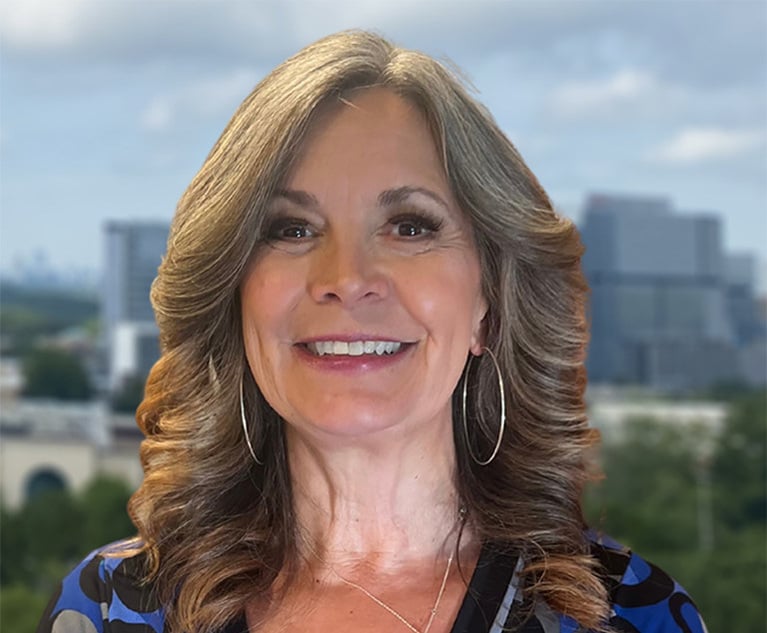Puerto Rico Offers Investment Opportunities for the Prepared and Selective
One of the oldest clichés in motivational speeches, and management in general, is that the Chinese character for “crisis” is composed of two subsidiary characters, one of which symbolizes “opportunity” and the other “danger.”
December 13, 2017 at 10:30 AM
21 minute read

One of the oldest clichés in motivational speeches, and management in general, is that the Chinese character for “crisis” is composed of two subsidiary characters, one of which symbolizes “opportunity” and the other “danger.” Sadly, one minute on Wikipedia will reveal that it's not actually true.
However, it's still true in Puerto Rico-if you're an investor who knows what you're doing and can tolerate risk. As so often happens, the horrific aftermath of Hurricane Maria's landfall on the island provides once-in-a-career opportunities for the prepared and the selective. It also provides a framework for helping rebuild the desperate situation for the 3.4 million people of Puerto Rico quickly and cost effectively.
On Sept. 20, Maria made landfall on the island, with winds peaking at 100 miles per hour. The resulting damage was catastrophic. The power grid, outdated to begin with, was destroyed. Restoring power will take months. Officially, 51 people were killed, with hundreds still missing and a total casualty count that will probably never be fully known. A month after Maria's landfall, more than half of the island's residents are still without potable water. The initial damage estimate was $90 billion, and a high percentage of the island's buildings were either leveled or severely damaged. To add insult to injury, this destruction occurred while Puerto Rico was already struggling in a financial crisis, following a decade of gradual economic decline, and a bankruptcy filing triggered by $70 billion in unserviceable debt. The picture could hardly be bleaker.
Or could it? Unlike virtually all of its sister islands in the Caribbean, Puerto Rico has some special characteristics which provide the possibility of light, however dim and flickering, at the end of the tunnel–and opportunity for U.S. investors. First and foremost, it is a U.S. territory, albeit not a state. Travel between the island and the mainland is unrestricted, the U.S. court and legal systems are in operation, the currency is the U.S. dollar, the banking system dovetails with ours and the infrastructure, such as roads, bridges, water systems and power, will be rebuilt to American standards. It also means a certain degree of long-term financial stability, as well as a vested U.S. government interest in seeing the island recover.
That will require offshore investment, both in real estate and in Puerto Rican businesses in general. There is no question that the island will be rebuilt. But how, when, and by whom are still yet to be determined. The opportunities are enormous, but investing in Puerto Rico is not for amateurs. To provide some context, I spoke with some other knowledgeable professionals on the topic; here are some things this group urges you to keep in mind:
First, investors need to think long term and plan for volatility, according to Jeremy Larkin, co-chair of NAI Miami, a real estate brokerage and advisory firm with expertise in Puerto Rican real estate. The full economic impact of Maria, combined with the existing economic slump in Puerto Rico, means that investors need to plan for a buy-and-hold strategy rather than anticipating a quick return.
There is, says Larkin, a temporary tailwind right now in the island's real estate market, powered by federal relief agencies needing office space, warehouses and bases of operation. Once that's abated, recovery will be prolonged and slow, particularly given the expected emigration of 10 percent of the island's population for the mainland, and the subsequent hit to the island's tax base. While real estate is currently available at enormous discounts-in some cases, 30 cents on the dollar-realizing a return will take patience. Recovery from a disaster of this magnitude typically takes about five years.
The recovery will also not happen evenly, says Miles Plaskett, one of my colleagues in Duane Morris' Miami office. According to Plaskett, the first sector to recover, and the most immediate investment target, will be construction and its related business. When ports, power grids and highways need to be rebuilt and hardened to American standards, construction and heavy equipment come first. Close on the heels of construction will be energy and power, particularly renewable energy, followed by pharmaceuticals, hospitals and medical care and finally, tourism. Recovery, however, will be hampered by the loss of population, and the commensurate drop in revenues. Rebuilding a power grid or a shopping center is a less attractive undertaking when there are significantly fewer customers and businesses to pay for it. Accordingly, lenders and financing sources will be looking closely at the ROI for projects and the creditworthiness of borrowers.
Plaskett, a native of the U.S. Virgin Islands, emphasizes that outside investors absolutely need an experienced local team on the ground in Puerto Rico. As with everywhere else in the world, Puerto Rican business and politics are inextricably intertwined, and there's no substitute for working with experts–-attorneys, real estate consultants, bankers–-who understand the landscape and business culture.
Plaskett's point is echoed by Arnaldo Oliveras-Fernandez, principal and managing partner of NAI Puerto Rico which is co-owned with NAI Miami. A specialist in retail properties and real estate investment, Oliveras-Fernandez points out that investors will find good opportunities only by taking advantage of local expertise. Most of the best available properties are not promoted, but rather, are known within the network of Puerto Rican professionals who not only have the needed information, but know how to ask the right questions, and make things happen. For example, if a shopping center that is for sale was foreclosed, a potential buyer needs to know why. Who were the owners? The previous tenants? What went wrong? Similarly, this network includes people like expediters, who can accelerate the 30- to 45-day permitting process.
Oliveras-Fernandez also points up an even more intriguing opportunity in Puerto Rico. Even prior to Maria, Puerto Rico's infrastructure was hobbled by a dearth of investment and aging equipment and facilities, particularly telecommunications and data networks that Oliveras-Fernandez characterizes as “prehistoric.” Maria destroyed much of what remained, leaving the island without internet access or power.
Into this breach stepped, among other enterprises, Tesla, with a potentially islandwide beta test of a new power plant and Powerwall battery packs to supply power, among other technological advancements, and Google, which began providing Internet access through solar-powered hot air balloons. Oliveras-Fernandez believes that the participation of big American tech companies in what is effectively a suddenly empty market could vault Puerto Rico ahead in technology, and make it more tech-savvy and competitive.
The final double-edged sword for businesses considering setting up in Puerto Rico is taxation. Bill Rohrer, my partner in Duane Morris's Miami office and an international tax lawyer, confirms that some businesses can operate much more tax-efficiently in Puerto Rico than in the mainland United States, with an effective tax rate significantly below what a “C” corporation or an offshore company would pay. Additionally, special tax incentives are on the books for a range of industries. It's a long list, and includes (in part) R&D, advertising, public relations, consulting, financial and professional services and insurance, some manufacturing, tourism (hotels), construction, telecoms, renewable energy (income from selling, leasing, installing materials and equipment used for producing green energy), and film. As in all tax-related matters, however, the devil is in the financial details, and the counsel of a professional is a must.
Ultimately, like all hurricanes, Maria dissipated. The suffering and the destruction are, however, a lingering fact, and it's not possible, alas, to turn back the clock and undo the devastation on the ground. What is possible, however, is to rebuild the infrastructure of the island rapidly, expertly and strategically, and to help the people who call it home restart their lives. All of which will require investment, which in turn requires the promise of a return. There is no such thing as risk-free return, but by working with the right team, and investing strategically and patiently, there are returns to be had–you know–where the opportunity outweighs the danger.
The investment opportunities, and the Puerto Rican people, await the wholesale involvement of the mainland's investment dollars and good will.
Jay Steinman is a senor real estate partner in Duane Morris' Miami office. He has more than 30 years of experience in complex commercial real estate and finance transactions in the United States, Puerto Rico and the Caribbean.

One of the oldest clichés in motivational speeches, and management in general, is that the Chinese character for “crisis” is composed of two subsidiary characters, one of which symbolizes “opportunity” and the other “danger.” Sadly, one minute on Wikipedia will reveal that it's not actually true.
However, it's still true in Puerto Rico-if you're an investor who knows what you're doing and can tolerate risk. As so often happens, the horrific aftermath of Hurricane Maria's landfall on the island provides once-in-a-career opportunities for the prepared and the selective. It also provides a framework for helping rebuild the desperate situation for the 3.4 million people of Puerto Rico quickly and cost effectively.
On Sept. 20, Maria made landfall on the island, with winds peaking at 100 miles per hour. The resulting damage was catastrophic. The power grid, outdated to begin with, was destroyed. Restoring power will take months. Officially, 51 people were killed, with hundreds still missing and a total casualty count that will probably never be fully known. A month after Maria's landfall, more than half of the island's residents are still without potable water. The initial damage estimate was $90 billion, and a high percentage of the island's buildings were either leveled or severely damaged. To add insult to injury, this destruction occurred while Puerto Rico was already struggling in a financial crisis, following a decade of gradual economic decline, and a bankruptcy filing triggered by $70 billion in unserviceable debt. The picture could hardly be bleaker.
Or could it? Unlike virtually all of its sister islands in the Caribbean, Puerto Rico has some special characteristics which provide the possibility of light, however dim and flickering, at the end of the tunnel–and opportunity for U.S. investors. First and foremost, it is a U.S. territory, albeit not a state. Travel between the island and the mainland is unrestricted, the U.S. court and legal systems are in operation, the currency is the U.S. dollar, the banking system dovetails with ours and the infrastructure, such as roads, bridges, water systems and power, will be rebuilt to American standards. It also means a certain degree of long-term financial stability, as well as a vested U.S. government interest in seeing the island recover.
That will require offshore investment, both in real estate and in Puerto Rican businesses in general. There is no question that the island will be rebuilt. But how, when, and by whom are still yet to be determined. The opportunities are enormous, but investing in Puerto Rico is not for amateurs. To provide some context, I spoke with some other knowledgeable professionals on the topic; here are some things this group urges you to keep in mind:
First, investors need to think long term and plan for volatility, according to Jeremy Larkin, co-chair of NAI Miami, a real estate brokerage and advisory firm with expertise in Puerto Rican real estate. The full economic impact of Maria, combined with the existing economic slump in Puerto Rico, means that investors need to plan for a buy-and-hold strategy rather than anticipating a quick return.
There is, says Larkin, a temporary tailwind right now in the island's real estate market, powered by federal relief agencies needing office space, warehouses and bases of operation. Once that's abated, recovery will be prolonged and slow, particularly given the expected emigration of 10 percent of the island's population for the mainland, and the subsequent hit to the island's tax base. While real estate is currently available at enormous discounts-in some cases, 30 cents on the dollar-realizing a return will take patience. Recovery from a disaster of this magnitude typically takes about five years.
The recovery will also not happen evenly, says Miles Plaskett, one of my colleagues in
Plaskett, a native of the U.S. Virgin Islands, emphasizes that outside investors absolutely need an experienced local team on the ground in Puerto Rico. As with everywhere else in the world, Puerto Rican business and politics are inextricably intertwined, and there's no substitute for working with experts–-attorneys, real estate consultants, bankers–-who understand the landscape and business culture.
Plaskett's point is echoed by Arnaldo Oliveras-Fernandez, principal and managing partner of NAI Puerto Rico which is co-owned with NAI Miami. A specialist in retail properties and real estate investment, Oliveras-Fernandez points out that investors will find good opportunities only by taking advantage of local expertise. Most of the best available properties are not promoted, but rather, are known within the network of Puerto Rican professionals who not only have the needed information, but know how to ask the right questions, and make things happen. For example, if a shopping center that is for sale was foreclosed, a potential buyer needs to know why. Who were the owners? The previous tenants? What went wrong? Similarly, this network includes people like expediters, who can accelerate the 30- to 45-day permitting process.
Oliveras-Fernandez also points up an even more intriguing opportunity in Puerto Rico. Even prior to Maria, Puerto Rico's infrastructure was hobbled by a dearth of investment and aging equipment and facilities, particularly telecommunications and data networks that Oliveras-Fernandez characterizes as “prehistoric.” Maria destroyed much of what remained, leaving the island without internet access or power.
Into this breach stepped, among other enterprises, Tesla, with a potentially islandwide beta test of a new power plant and Powerwall battery packs to supply power, among other technological advancements, and
The final double-edged sword for businesses considering setting up in Puerto Rico is taxation. Bill Rohrer, my partner in
Ultimately, like all hurricanes, Maria dissipated. The suffering and the destruction are, however, a lingering fact, and it's not possible, alas, to turn back the clock and undo the devastation on the ground. What is possible, however, is to rebuild the infrastructure of the island rapidly, expertly and strategically, and to help the people who call it home restart their lives. All of which will require investment, which in turn requires the promise of a return. There is no such thing as risk-free return, but by working with the right team, and investing strategically and patiently, there are returns to be had–you know–where the opportunity outweighs the danger.
The investment opportunities, and the Puerto Rican people, await the wholesale involvement of the mainland's investment dollars and good will.
Jay Steinman is a senor real estate partner in
This content has been archived. It is available through our partners, LexisNexis® and Bloomberg Law.
To view this content, please continue to their sites.
Not a Lexis Subscriber?
Subscribe Now
Not a Bloomberg Law Subscriber?
Subscribe Now
NOT FOR REPRINT
© 2025 ALM Global, LLC, All Rights Reserved. Request academic re-use from www.copyright.com. All other uses, submit a request to [email protected]. For more information visit Asset & Logo Licensing.
You Might Like
View All
SEC Whistleblower Program: What to Expect Under the Trump Administration
6 minute read
Turning the Shock of a January Marital Split Into Effective Strategies for Your Well-Being
5 minute read

Trending Issues in Florida Construction Law That Attorneys Need to Be Aware Of
6 minute readTrending Stories
- 1Carol-Lisa Phillips to Rise to Broward Chief Judge as Jack Tuter Weighs Next Move
- 2Data Breaches in UK Legal Sector Surge, According to ICO Data
- 3Georgia Law Schools Seeing 24% More Applicants This Year
- 4After Shutting USAID, Trump Eyes Department of Education, CFPB
- 5‘Keep Men Out’: Female Swimmers Sue Ivy Leagues Over Lia Thomas’ Sweep
Who Got The Work
J. Brugh Lower of Gibbons has entered an appearance for industrial equipment supplier Devco Corporation in a pending trademark infringement lawsuit. The suit, accusing the defendant of selling knock-off Graco products, was filed Dec. 18 in New Jersey District Court by Rivkin Radler on behalf of Graco Inc. and Graco Minnesota. The case, assigned to U.S. District Judge Zahid N. Quraishi, is 3:24-cv-11294, Graco Inc. et al v. Devco Corporation.
Who Got The Work
Rebecca Maller-Stein and Kent A. Yalowitz of Arnold & Porter Kaye Scholer have entered their appearances for Hanaco Venture Capital and its executives, Lior Prosor and David Frankel, in a pending securities lawsuit. The action, filed on Dec. 24 in New York Southern District Court by Zell, Aron & Co. on behalf of Goldeneye Advisors, accuses the defendants of negligently and fraudulently managing the plaintiff's $1 million investment. The case, assigned to U.S. District Judge Vernon S. Broderick, is 1:24-cv-09918, Goldeneye Advisors, LLC v. Hanaco Venture Capital, Ltd. et al.
Who Got The Work
Attorneys from A&O Shearman has stepped in as defense counsel for Toronto-Dominion Bank and other defendants in a pending securities class action. The suit, filed Dec. 11 in New York Southern District Court by Bleichmar Fonti & Auld, accuses the defendants of concealing the bank's 'pervasive' deficiencies in regards to its compliance with the Bank Secrecy Act and the quality of its anti-money laundering controls. The case, assigned to U.S. District Judge Arun Subramanian, is 1:24-cv-09445, Gonzalez v. The Toronto-Dominion Bank et al.
Who Got The Work
Crown Castle International, a Pennsylvania company providing shared communications infrastructure, has turned to Luke D. Wolf of Gordon Rees Scully Mansukhani to fend off a pending breach-of-contract lawsuit. The court action, filed Nov. 25 in Michigan Eastern District Court by Hooper Hathaway PC on behalf of The Town Residences LLC, accuses Crown Castle of failing to transfer approximately $30,000 in utility payments from T-Mobile in breach of a roof-top lease and assignment agreement. The case, assigned to U.S. District Judge Susan K. Declercq, is 2:24-cv-13131, The Town Residences LLC v. T-Mobile US, Inc. et al.
Who Got The Work
Wilfred P. Coronato and Daniel M. Schwartz of McCarter & English have stepped in as defense counsel to Electrolux Home Products Inc. in a pending product liability lawsuit. The court action, filed Nov. 26 in New York Eastern District Court by Poulos Lopiccolo PC and Nagel Rice LLP on behalf of David Stern, alleges that the defendant's refrigerators’ drawers and shelving repeatedly break and fall apart within months after purchase. The case, assigned to U.S. District Judge Joan M. Azrack, is 2:24-cv-08204, Stern v. Electrolux Home Products, Inc.
Featured Firms
Law Offices of Gary Martin Hays & Associates, P.C.
(470) 294-1674
Law Offices of Mark E. Salomone
(857) 444-6468
Smith & Hassler
(713) 739-1250






